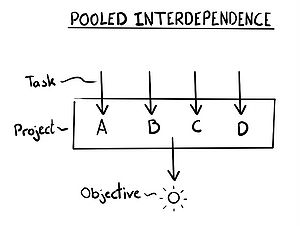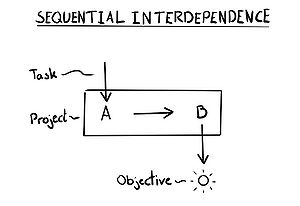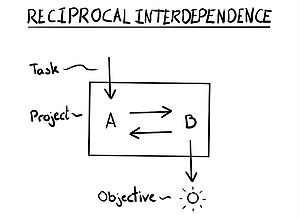Pooled, Sequential & Reciprocal dependence
(→J.D. Thompson and Organizations in Action) |
(→Big Idea) |
||
| Line 13: | Line 13: | ||
== Big Idea == | == Big Idea == | ||
| − | |||
=== Complexity === | === Complexity === | ||
| Line 25: | Line 24: | ||
While J.D. Thompson’s original theory on Pooled, Sequential and Reciprocal interdependence were targeted organisational structures, the theory can be applied to any type of “body” that consists of interconnected elements and tasks, such as projects, programs and portfolios. For the sake of the course and to ensure high relevancy to the reader, the theory will be applied to a project level instead of organisational structures. In later sections, this will be expanded to program and portfolio levels as well. | While J.D. Thompson’s original theory on Pooled, Sequential and Reciprocal interdependence were targeted organisational structures, the theory can be applied to any type of “body” that consists of interconnected elements and tasks, such as projects, programs and portfolios. For the sake of the course and to ensure high relevancy to the reader, the theory will be applied to a project level instead of organisational structures. In later sections, this will be expanded to program and portfolio levels as well. | ||
| − | |||
| − | |||
| − | |||
| − | |||
| − | |||
| − | |||
=== Types of interdependencies === | === Types of interdependencies === | ||
| Line 54: | Line 47: | ||
==== Reciprocal interdependency ==== | ==== Reciprocal interdependency ==== | ||
| + | |||
| + | === Purpose === | ||
| + | * Improve resource management | ||
| + | * Improve resource efficiency | ||
| + | * Mitigate uncertainties (time management) | ||
| + | * Mitigate risk (Less uncertainty) | ||
==== Other interdependencies ==== | ==== Other interdependencies ==== | ||
Revision as of 14:56, 20 April 2023
Motivation An article on this topic already exists on the wiki. However, I believe I can improve/supplement this article on a number of points: 1) Elaborate on the application potential of the different types of dependencies. 2) Supplement the original theory, from James D. Thomson’s Organizations in Action, with today’s perspective on it (how the theory has evolved). 3) Take the theory from its original focus on project management and discuss its application potential on program and portfolio management levels. 4) Describe dependencies’ ability to work as a Risk Management tool
The topic is highly relevant to our case, and I hope this can be used to write a better article as well as prove useful on the case work.
Contents |
Abstract (Draft)
A project consists of a series of tasks that need to be executed in order to complete it. The way these tasks are arranged in relation to each other will come down to their dependence. According to James D. Thompson, task dependence can be distinguished into three types: Pooled, Sequential and Reciprocal. For a Project Manager dependencies can be a powerful tool in managing the complexity of a project. Using dependencies to characterise tasks in a project will help to determine the sequence of which tasks should be completed in order to optimise time use, resources, workers, etc. A way dependencies are not used much yet is on the levels above project management, namely program and portfolio management. Here, dependencies could prove useful in terms of optimising efficiency in a program or portfolio setting, spanning across several projects. All this will be explored in greater detail and described in the article.
Big Idea
Complexity
A project consists of a series of interdependent tasks. These need to be completed in a certain manner which is determined by each task’s link(s) to other tasks. In this way, a project can be seen as a dynamic system where factors such as the number of tasks, their interconnectivity, uncertainty and ambiguity makes up a projects degree of complexity.[1] A Project Managers ability to manage this complexity, in any variable shape or form it might take, is crucial for a projects chance of success. Tools that help deal with the different factors of complexity are therefore important for Project Managers to know about.
One such tool is the three types of interdependence, defined by J.D. Thompson in 1967.
J.D. Thompson and Organizations in Action
While J.D. Thompson’s original theory on Pooled, Sequential and Reciprocal interdependence were targeted organisational structures, the theory can be applied to any type of “body” that consists of interconnected elements and tasks, such as projects, programs and portfolios. For the sake of the course and to ensure high relevancy to the reader, the theory will be applied to a project level instead of organisational structures. In later sections, this will be expanded to program and portfolio levels as well.
Types of interdependencies



As described in the ”Complexity” section, projects consists of a number of tasks with varying degrees of interdependence between each other. This does not entail that all tasks are directly connected. What is meant by interdependence is that all tasks in a project works towards a common objective[3] and if one task fails it might impact the changes of success for that objective, thereby impacting all tasks connected to it[2].
For a project manager it is necessary to be able to address these interdependencies and use them to structure the tasks of a project. First step towards this is being able to distinguish and identify different types of interdependencies, and subsequently know how to handle tasks depending on which type they are. J.D. Thompson defined three types of interdependencies which will be further described in the sections below. As it has been quite a while since the J.D. Thompsons original theory was published for the first time, the field of interdependence has been expanded upon. Some of these additions (INSERT EXAMPLES) to the theory will also be described.
Pooled interdependency
Of the three types of interdependencies that J.D. Thompson defines, pooled interdependence is the simplest. When a project contains a series of tasks of which non of them are directly connected or dependent on each other, these tasks are still working towards a common deliverable. Therefore, each of the tasks are still indirectly dependent on that the other tasks are completed, as the projects end deliverable will not be achieved otherwise. Every task works independently towards completing a common goal as visualised as seen on Fig. 1.[2] To give an example, INSERT EXAMPLE.
Sequential interdependency
The second interdependency defined by Thompson is referred to as sequential interdependence.
Reciprocal interdependency
Purpose
- Improve resource management
- Improve resource efficiency
- Mitigate uncertainties (time management)
- Mitigate risk (Less uncertainty)
Other interdependencies
- Benefit interdependencies
- Risk interdependencies
- Financial interdependencies
- Outcome interdependencies
- Schedule interdependencies
- Resource interdependencies
- Intensive interdependecies
Application
Project level
OBS: The following sections are placeholders - There appears to be a valid argument for distinguishing between applying dependencies on the 3P’s of management, but whether these are different enough to justify their own header is not yet clear.
Program level
Benefits:
- Tracking of benefit realisation across projects —> Program Management Performance Domains (PMI standard)
Portfolio level
Benefits:
- Strategic portfolio management (Good for overview —> Going from goal to action)
- Use in portfolio governance
Optimising processes
Applying interdependencies in other settings
Looking at how to apply the theory on a project, program and portfolio level in various types of companies.
Limitations
A look into how the field have developed since the original introduction in 1967. How the old theory falls short (Lack of depth and distinguish between the three original types of dependency)
Annotated Bibliography
OBS: This sections is used to store current sources and will be revised. Therefore, not all sources here are being used in the text, as of yet.
Bilgin, G. et al. (2017) “Handling project dependencies in portfolio management,” Procedia Computer Science, 121, pp. 356–363. Available at: https://doi.org/10.1016/j.procs.2017.11.048. - Article on applying dependency management on a cross-project portfolio level
Knotten, V. et al. (2015) “Design management in the building process - A review of current literature,” Procedia Economics and Finance, 21, pp. 120–127. Available at: https://doi.org/10.1016/s2212-5671(15)00158-6. - Article looking at the current practices of using dependencies
Kwan, T.W. and Leung, H.K.N. (2011) “A risk management methodology for Project Risk Dependencies,” IEEE Transactions on Software Engineering, 37(5), pp. 635–648. Available at: https://doi.org/10.1109/tse.2010.108. - Article on identifying dependencies between risks in order to create better risk management
Lemak, D.J. and Reed, R. (2000) “An application of Thompson's typology to TQM in service firms,” Journal of Quality Management, 5(1), pp. 67–83. Available at: https://doi.org/10.1016/s1084-8568(00)00013-4. - Article on how to apply the theory of Thompson, J.D. in an untypical setting. Here a service firm
(*)Lundberg, C.C. and Thompson, J.D. (1967) “Organizations in action.,” Administrative Science Quarterly, 12(2), p. 339. Available at: https://doi.org/10.2307/2391555. - The original introduction of the Pooled, Sequential & Reciprocal dependence theory
Mach, M., C.M. Abrantes, A., & Soler, C. (2021). Teamwork in Healthcare Management. Teamwork in Healthcare. doi: 10.5772/intechopen.96826 - Article on using interdependence in a Health care setting, and expanding the original theory. Used as inspiration for models.
Tan, F. T., Pan, S. L., & Zuo, M. (2018). Realising platform operational agility through information technology–enabled capabilities: A resource‐interdependence perspective. Information Systems Journal, 29(3), 582–608. https://doi.org/10.1111/isj.12221
Tsvetkova, A., Eriksson, K., Levitt, R. E., & Wikstrom, K. (2019). Workflow interdependence analysis of projects in business ecosystems. The Engineering Project Organization Journal, 8, 1-18. - Application of the Thompson, J.D. theory in a different setting
Volkoff, O., Strong, D.M. and Elmes, M.B. (2005) “Understanding enterprise systems-enabled integration,” European Journal of Information Systems, 14(2), pp. 110–120. Available at: https://doi.org/10.1057/palgrave.ejis.3000528. - Article on using Thompson, J.D.’s dependency theory to understand and optimise company work processes,,,
References
- ↑ Geraldi, J., Thuesen, C., Oehmen, J., & Stingl, V. (2017). Doing Projects. A Nordic Flavour to Managing Projects: DS-handbook 185:2017. Dansk Standard.
- ↑ 2.0 2.1 2.2 2.3 2.4 Thompson, J. D. (1973). Organizations in action: Social science bases of administrative theory. McGraw-Hill.
- ↑ International Organization for Standardization & Dansk Standard. (2021). Project, programme and portfolio management – Context and concepts (Standard No. 21500). Retrieved from https://sd.ds.dk/Viewer?ProjectNr=M351701&Status=60.60&Inline=true&Page=1&VariantID=41